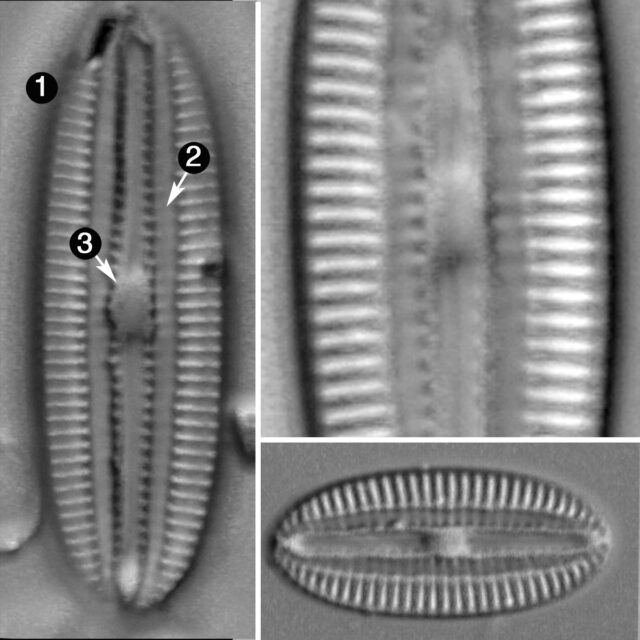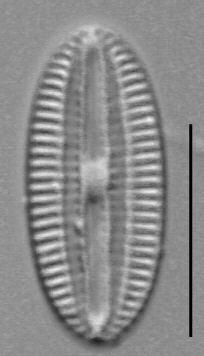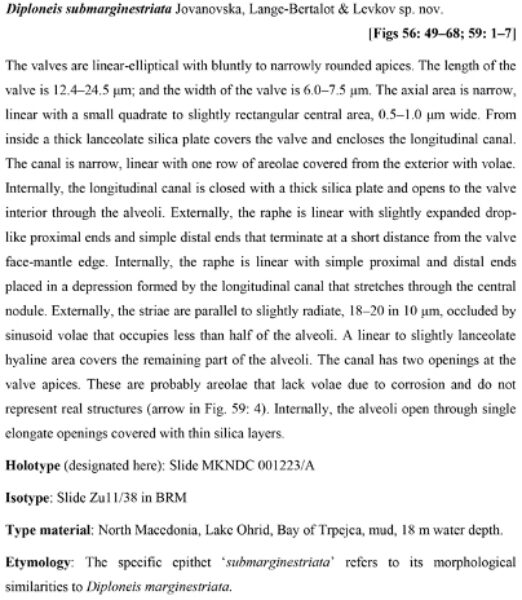Diploneis submarginestriata
-
Category
-
Length Range12.2-23.3 µm
-
Width Range6.2-7.4 µm
-
Striae in 10 µm18-20
-
ContributorMelissa Vaccarino - Mar 2016
-
ReviewerSarah Spaulding - Mar 2018
Identification
Description
Valves are elliptic-linear, with broadly rounded apices. The central area is small, and not inflated at the central area. The raphe is narrow. The longitudinal canals are straight and nearly parallel throughout the length of the valve. Striae are slightly radiate. In larger specimens, the striae are nearly parallel in the center, and become radiate near the apices. Areolae are not discernable in LM.
As noted in the UPDATE tab, the images on this page were originally posted as D. marginestriata.
According to Lange-Bertalot et al. (2020), the taxa D. submarginestriata, D. marginestriata, and D. oculata are very similar. Based on lectotype material, D. marginestriata is 18-41 µm in length and 9-11 µm in breadth with a stria density of 17-18 in 10 µm.
To date, specimens in North America have been fit into D. marginestriata. However, closer examination is needed to determine if D. marginestriata occurs here.
Autecology
This species is not common in North America, but it has been found across the the U.S. It has been reported from rivers of the southeast and California in USGS surveys, and in lakes sediments of the northeast in an EPA survey (as D. marginestriata).
-
Size Range, µm3
-
Motility
-
Attachment
-
Habitat
-
Colony
-
Occurrence
-
Waterbody
-
Distribution
- Learn more about this
Original Description
The valves are linear-elliptical with bluntly to narrowly rounded apices. The length of the valve is 12.4–24.5 μm; and the width of the valve is 6.0–7.5 μm. The axial area is narrow, linear with a small quadrate to slightly rectangular central area, 0.5–1.0 μm wide. From inside a thick lanceolate silica plate covers the valve and encloses the longitudinal canal. The canal is narrow, linear with one row of areolae covered from the exterior with volae. Internally, the longitudinal canal is closed with a thick silica plate and opens to the valve interior through the alveoli. Externally, the raphe is linear with slightly expanded drop- like proximal ends and simple distal ends that terminate at a short distance from the valve face-mantle edge. Internally, the raphe is linear with simple proximal and distal ends placed in a depression formed by the longitudinal canal that stretches through the central nodule. Externally, the striae are parallel to slightly radiate, 18–20 in 10 μm, occluded by sinusoid volae that occupies less than half of the alveoli. A linear to slightly lanceolate hyaline area covers the remaining part of the alveoli. The canal has two openings at the valve apices. These are probably areolae that lack volae due to corrosion and do not represent real structures (arrow in Fig. 59: 4). Internally, the alveoli open through single elongate openings covered with thin silica layers.
-
AuthorJovanovska, Lange-Bert. and Levkov 2020
-
Length Range12.4–24.5 µm
-
Width6.0–7.5 µm
-
Striae in 10µm18–20
Citations & Links
Citations
-
Publication Link: 10.1080/0269249X.2013.797219
Links
Updates
Mar 16, 2021 - Change in taxon name
From November 4, 2015 to March 13, 2021, the images on this page appeared under the name D. marginestriata Hust. Following recent works (Lange-Bertalot et al. 2021), the page was updated to D. submarginestriata Jovanoska et al. - E. Jovanoska and S. Spaulding
Cite This Page
Vaccarino, M. (2016). Diploneis submarginestriata. In Diatoms of North America. Retrieved July 26, 2024, from https://diatoms.org/species/diploneis_submarginestriata
Responses
The 15 response plots show an environmental variable (x axis) against the relative abundance (y axis) of Diploneis submarginestriata from all the stream reaches where it was present. Note that the relative abundance scale is the same on each plot. Explanation of each environmental variable and units are as follows:
ELEVATION = stream reach elevation (meters)
STRAHLER = distribution plot of the Strahler Stream Order
SLOPE = stream reach gradient (degrees)
W1_HALL = an index that is a measure of streamside (riparian) human activity that ranges from 0 - 10, with a value of 0 indicating of minimal disturbance to a value of 10 indicating severe disturbance.
PHSTVL = pH measured in a sealed syringe sample (pH units)
log_COND = log concentration of specific conductivity (µS/cm)
log_PTL = log concentration of total phosphorus (µg/L)
log_NO3 = log concentration of nitrate (µeq/L)
log_DOC = log concentration of dissolved organic carbon (mg/L)
log_SIO2 = log concentration of silicon (mg/L)
log_NA = log concentration of sodium (µeq/L)
log_HCO3 = log concentration of the bicarbonate ion (µeq/L)
EMBED = percent of the stream substrate that is embedded by sand and fine sediment
log_TURBIDITY = log of turbidity, a measure of cloudiness of water, in nephelometric turbidity units (NTU).
DISTOT = an index of total human disturbance in the watershed that ranges from 1 - 100, with a value of 0 indicating of minimal disturbance to a value of 100 indicating severe disturbance.

Diploneis submarginestriata
- Valves narrow, linear
- Longitudinal canals linear
- Central area nearly linear
Valves are narrow and linear. The longitudinal canals are linear, with no inflation, or only slight inflation, at the central area. Areolae are not discernible in LM.
 Diatoms of North America
Diatoms of North America



